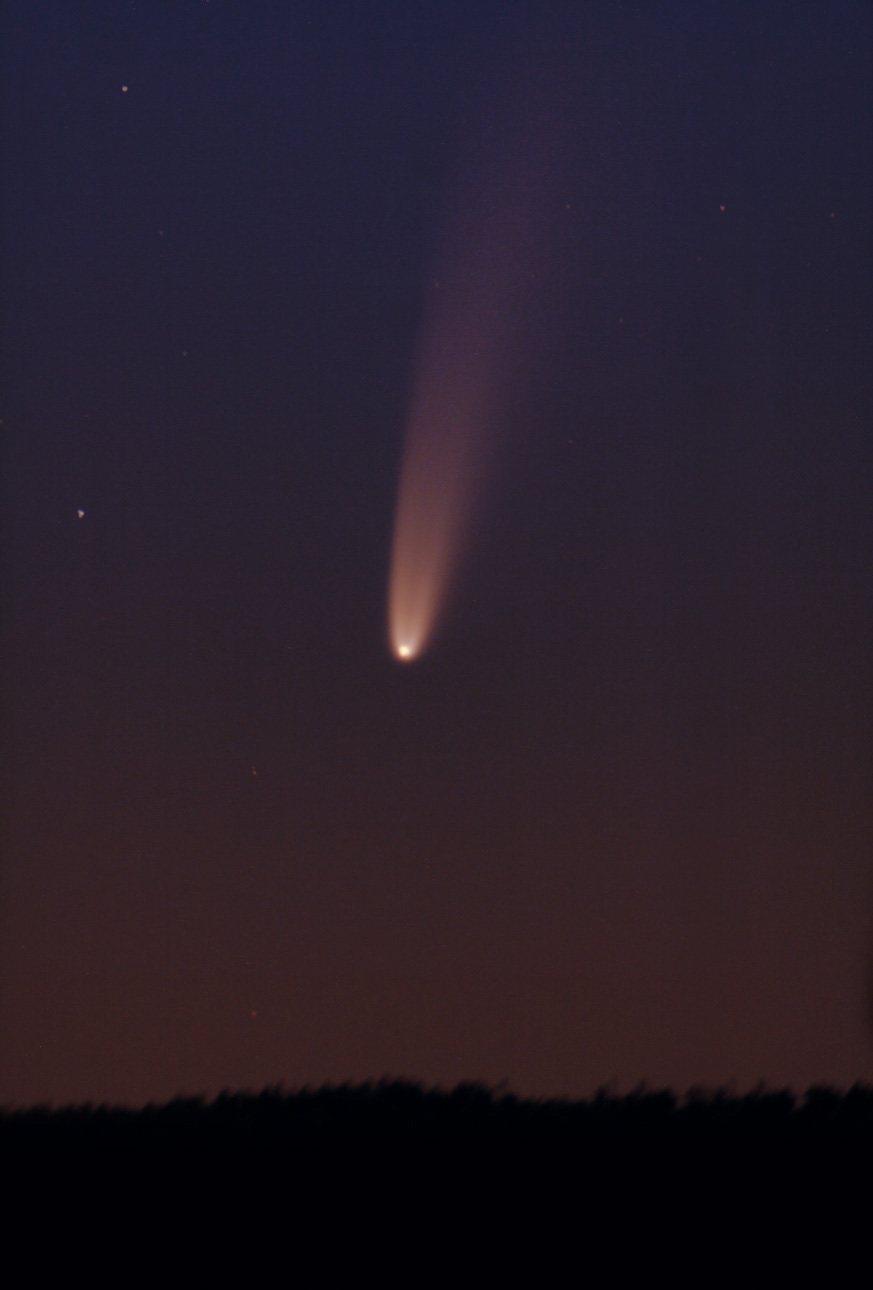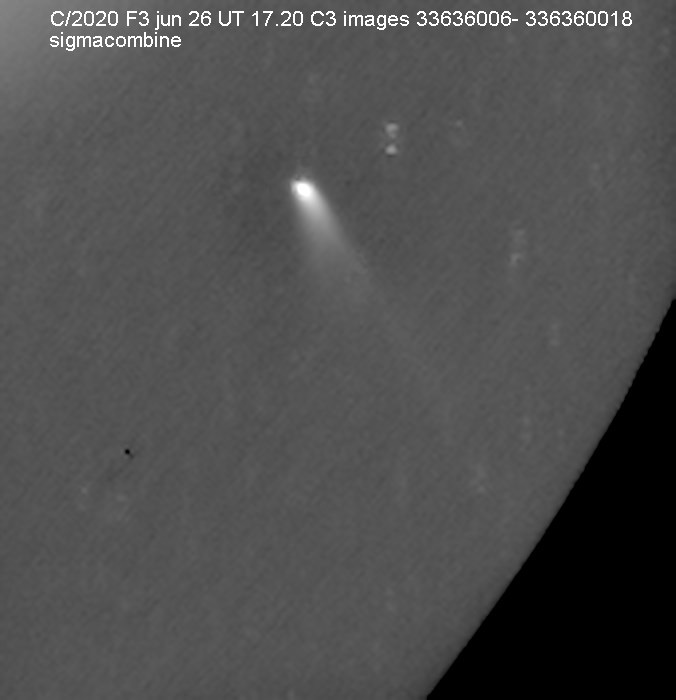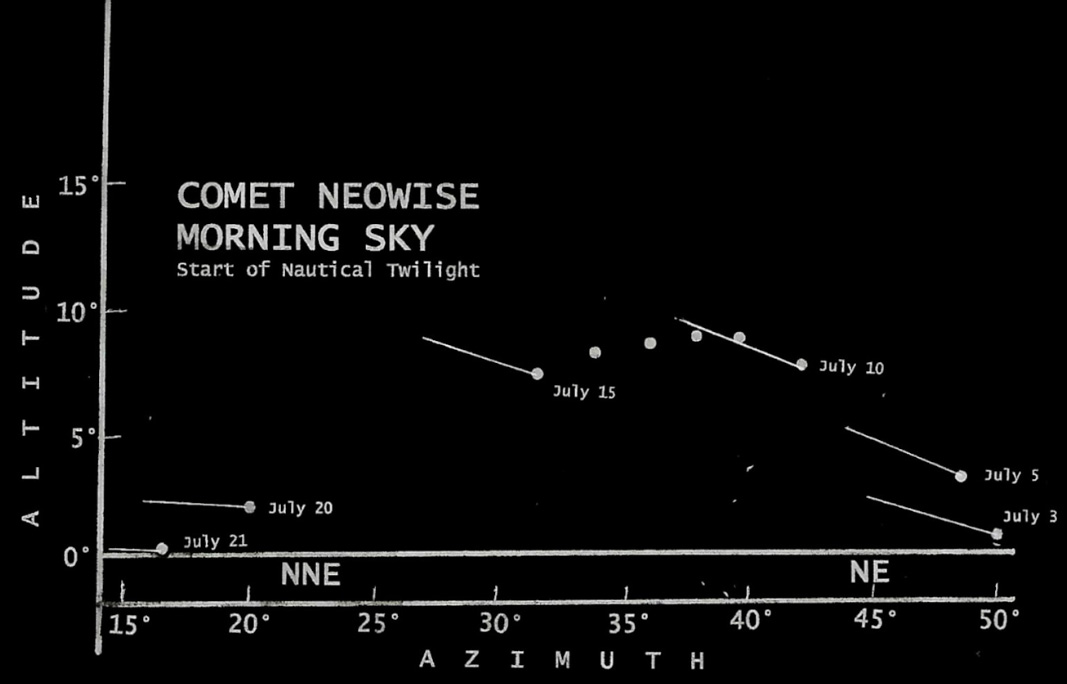Comet NEOWISE could give skywatchers a dazzling show this month. Here's what to know.
Earlier this year, the NEOWISE space telescope discovered its latest comet, a distant and inconspicuous object.
At the time of its discovery on March 27, the comet — dubbed Comet NEOWISE (short for Near Earth Object Wide-field Infrared Survey Explorer) and cataloged as C/2020 F3, was located 194 million miles (312 million kilometers) from the sun and shining at a very faint magnitude of +17 — that's about 25,000 times fainter than the faintest star that can be glimpsed with the naked eye. It was only visible with large telescopes.
But in July, Comet NEOWISE has raised hopes that it will become a tantalizing object for skywatchers after two previous comets (ATLAS and SWAN) fizzled out earlier this year.
When we talk about the comet's brightness below, we'll be discussing its magnitude — a measurement of an object's brightness in the sky. The lower the magnitude, the brighter the object. The brightest stars in the sky are zero or first magnitude. The faintest stars visible to the eye on dark, clear nights are sixth magnitude. First magnitude stars are 100 times brighter than those of sixth magnitude.
Related: Comet SWAN: A brilliant 'icy wanderer' in photos
Third time a comet charm?
Comet NEOWISE survived its closest approach to the sun, (perihelion) unlike its 2020 predecessors, comets ATLAS and SWAN. All the way into its approach to the sun, NEOWISE displayed a perfectly circular and well-condensed head, or coma compared to the faint, wispy, almost ghostly coma displayed by Comet ATLAS and the "hammerhead" looking coma of Comet SWAN, which foretold a possible break-up. As it turned out, both of those objects indeed faded away long before either reached the vicinity of the sun.
Well before NEOWISE's solar arrival on Friday (July 3), veteran Australian comet watcher, Michael Mattiazzo was confident that NEOWISE would remain intact, giving at least a 70% chance that it would survive its close brush with the sun.
Breaking space news, the latest updates on rocket launches, skywatching events and more!
And apparently it did! The comet was 27.3 million miles (44 million km) from the sun on July 3, when it was subjected to temperatures of up to 1,100 degrees Fahrenheit (593 degrees Celsus). Thereafter, rapid motion to the northeast and then east, owing to the comet's sharp orbital inclination to the orbital plane of the planets, will quickly carry it away from the sun's vicinity in the days to follow.
Astrophotographer Chris Schur spotted Comet NEOWISE early today (July 5) from Payson Arizona.
"The comet continues to be stunning, rising tail first over the plateau, some 20 miles distant," Schur told Space.com while sharing photo he captured through an Explore Scientific AR152 mm telescope. "I was able to easily see it naked eye with about a degree of tail visually. Gorgeous yellow color in the scope."
An overachiever!
Originally, NEOWISE was not expected to get much brighter than ninth or 10th magnitude, making it accessible only to those with good binoculars or small telescopes. But during the spring, observers in the Southern Hemisphere followed the very rapid brightening of this object as its distances from both the sun and Earth decreased. A consensus of observations placed it at magnitude +9.9 on May 10.
Just under a month late, on June 7, the comet was on the far side of the sun, 73 million miles (117 million km) distant from the star and 147 million miles (236 million km) from Earth. It had increased 12-fold in brightness to a magnitude +7.2. As projected on the sky, the comet was scarcely 24 degrees from the sun (a closed fist at the end of an outstretched arm covers 10 degrees of the sky) and the two were rapidly closing together. Shortly thereafter, the comet was lost to observers in the increasing glare of the sun.
But from June 22 through June 27, the comet was within the range of the Solar and Heliospheric Observatory (SOHO). SOHO is a cooperative mission between the European Space Agency (ESA) and NASA. The spacecraft is stationed in a halo orbit around the sun-Earth L1 Lagrangian point, a position roughly 930,000 miles (1.5 million km) sunward of Earth. At this point in space, the orbital period of SOHO exactly matches the orbital period of Earth. From this orbit, SOHO is able to observe the sun 24 hours a day.
Using its Large Angle and Spectrometric Coronagraph (LASCO-3), which can create an artificial solar eclipse, NEOWISE could be monitored as it passed near to the sun. During this time, the comet appeared to significantly brighten, with comet expert Charles Morris estimating a magnitude of +1.7 just before it passed out of the field of the LASCO-3 camera. Comet NEOWISE also appeared to have developed a rather bright, albeit short and stubby forked-shaped dust tail.
Surprise!
And then, quite unexpectedly, amateur astronomers were able to make sightings of Comet NEOWISE before sunrise beginning on July 1.
"Wow-- it was very bright, near magnitude +1," Ray Brooks of the Arizona Sky Village near Tucson saw the comet through binoculars and told Space.com. "If the comet were in dark skies at a decent elevation, it would be a spectacular naked-eye object."
On the morning of July 4, Brooks could see Comet NEOWISE's forked double tail break the top of a nearby mountain first, followed by the comet head.
Another assiduous Arizona comet watcher is astronomer Carl Hergenrother of Tucson, who saw NEOWISE both on July 1 and July 2, describing as appearing at least as bright as a first magnitude star, in spite of it being very low to the horizon and against a bright twilight sky.
And the highly reputable comet expert, John E. Bortle of Stormville, New York was amazed at the comet's performance so far.
"Theoretically, the comet shouldn't still be brightening noticeably, as its distance to the sun is undergoing only a small reduction day-to-day at this point, making me think that the comet's current brightness is not being governed mainly by its distance from the sun but, rather it is experiencing some manner of progressive slow outburst," he said.
Is this a Great Comet in the making?
Comets fall into two categories. "Common" comets are faint fuzz-balls that are visible only with the help of good binoculars or telescopes. Tonight, for instance, there are perhaps eight or 10 such comets in our sky.
Then, there are the "Great" comets, those that become bright enough to be plainly visible with the naked eye and accompanied by a striking tail of dust and gas. Unfortunately, such displays do not come around very often. In the average human lifespan, you may get a chance to see perhaps four if you are very fortunate.
The last great comet visible from the Northern Hemisphere was Comet Hale-Bopp in 1997, but is NEOWISE developing into one right now? Based on the very latest brightness estimates, Comet NEOWISE might fall just short of the criteria, though once it becomes evident in darker skies it should be quite obvious, especially away from light polluted cities.
When and where to look
NEOWISE is about to take center stage, which we visualize in two diagrams; one for the morning sky and the other for the evening sky. The time frames are for the beginning (morning) and end (evening) of nautical twilight, when the sun is positioned 12 degrees below the horizon, corresponding to approximately 80 minutes before sunrise and 80 minutes after sunset for those living at mid-northern latitudes. The lines extend directly away from the sun, showing the probable direction in the sky of the comet’s tail should one develop.
In the morning sky, the first views of NEOWISE could come as early as July 5 or 6 in the morning sky, very low above the northeast horizon. By around July 11, the comet will reach an altitude of nearly 10 degrees — for comparison, 10 degrees is roughly equal to the width of your fist held at arm's length. Then over the next 10 days it will gradually slide back down toward the north-northeast horizon, eventually disappearing from dawn visibility.
A far-better viewing perspective will become available in the evening sky starting around July 12, when it will appear low in the northwest sky. In the evenings to follow, the comet will rapidly climb higher in the sky.
On July 22, NEOWISE will make its closest approach to the Earth, a distance of 64 million miles (103 million km). By July 25, the comet will appear 30 degrees ("three fists") up from the west-northwest horizon as darkness falls. And on July 30-31, the comet will be passing just to the north of the fine star cluster of Coma Berenices or Berenice's Hair.
Final thoughts
Although on successive July evenings the comet will grow fainter, it will be farther from sun, setting later and visible in a darker sky. As we move into August, the comet will be very well placed for observers with small telescopes.
Amateur observers should seek the most favorable conditions possible. Even a bright comet, like this one, can be obliterated by thin horizon clouds, haze, humid air, smoke, twilight glow, city lights, or moonlight. Of course, binoculars or telescopes will only enhance the view.
For the more technically inclined, or for those who own a "GoTo" Telescope, the ephemeris below is from calculations by Daniel Green. Positions are valid for 8 p.m. Eastern Daylight Time on every fourth date and provides the comet’s right ascension and declination; next is the comet’s elongation, or angular distance from the sun, followed by the constellation the comet is in, and lastly an approximate predicted magnitude.
Exciting times are ahead. NEOWISE is here. "Comet" get it!
| Date | Right Ascension | Declination | Elongation | Constellation | Magnitude |
| July 5 | 05h 07.20m | +34°04.8’ | 16° | Auriga | 0.7 |
| July 9 | 06h 34.38m | +40°24.3’ | 20° | Auriga | 1.2 |
| July 13 | 07h 24.78m | +45°41.0’ | 24° | Lynx | 2.0 |
| July 17 | 08h 40.20m | +48°11.1’ | 29° | Ursa Major | 2.7 |
| July 21 | 10h 06.66m | +46°01.9’ | 36° | Ursa Major | 3.5 |
| July 25 | 11h 20.33m | +39°40.1’ | 43° | Ursa Major | 4.3 |
| July 29 | 12h 12.71m | +31°40.6’ | 50° | Coma Bernices | 5.1 |
| Aug. 2 | 12h 48.45m | +24°06.0’ | 55° | Coma Bernices | 5.9 |
| Aug. 6 | 13h 13.52m | +17°41.2’ | 58° | Coma Bernices | 6.6 |
Joe Rao serves as an instructor and guest lecturer at New York's Hayden Planetarium. He writes about astronomy for Natural History magazine, the Farmers' Almanac and other publications. Follow us on Twitter @Spacedotcom and on Facebook.

Joe Rao is Space.com's skywatching columnist, as well as a veteran meteorologist and eclipse chaser who also serves as an instructor and guest lecturer at New York's Hayden Planetarium. He writes about astronomy for Natural History magazine, Sky & Telescope and other publications. Joe is an 8-time Emmy-nominated meteorologist who served the Putnam Valley region of New York for over 21 years. You can find him on Twitter and YouTube tracking lunar and solar eclipses, meteor showers and more. To find out Joe's latest project, visit him on Twitter.




